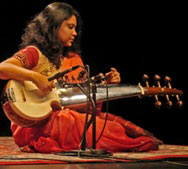SAROD
History
Sarod is a popular Indian classical musical instrument which is similar to the Western lute in structure. Among the followers and connoisseurs of Hindustani classical music Sarod is one of the most important musical instruments. As per scholars the source of the Sarod seems to be the rebab, a similar instrument that is said to have originated in Afghanistan and Kashmir. It is believed that the sarod is essentially a bass rebab.In 13th century multi talented and multi-faceted Amir Khusru modified the rebab. Many scholars of Indian classical music believe that sarod is a combination of the ancient chitra veena, the medieval rebab and modern sursingar. Some scholars even contend that a similar instrument may have existed about two thousand years ago in ancient India.
Sarods originally were a primitive tribal instrument. The great Sarod player virtuoso Baba Alauddin Khan greatly refined this instrument, bringing the sarod into its modern configuration by adding many different features. He then taught his son, Ali Akbar Khan, sarod at the same time as he was teaching Ravi Shankar to play sitar.
Introduction

Sarod has a small wooden body covered with skin and a fingerboard that is covered with steel. Sarod does not have a fret and has twenty-five strings of which fifteen are sympathetic strings. A metal gourd acts as a resonator. The strings are plucked with a triangular plectrum.
The Sarod's body is carved from a single piece of well-seasoned teakwood and the belly is covered with goat skin. There are four main strings, six rhythm and drone strings and fifteen sympathetic strings, all made of metal. These are played by striking with a plectrum made of a coconut shell.
Sarod has as been found in carvings of the 1st century in Champa temple and also in paintings in the Ajanta caves. It also has a similarity with the Rabab of Afghanistan and Kashmir. The instrument was modified by Amir Khusru in the 13th century. A definite change was made by Ustad Ali Akbar Khan in shape of the instrument for improving the tonal quality.
How to play a Sarod
The Sarod generally is three and half feet long and is made of wood. One end of the body is rounded nearly half a foot in diameter which is covered with parchment. The round part gradually joins the neck and there are six metallic main strings including the side strings for the drone and rhythmic accompaniment. These strings are fastened to pegs at the neck end of the instrument. In some varieties, a small gourd is also attached to the neck end. Sarod has eleven or twelve sympathetic strings which help to improve the resonance. The finger-board in Sarod is covered with a polished metal plate to facilitate the sliding of the fingers. The instrument is played with a plectrum held in the right hand while the fingers of the left hand are used for stopping the strings and playing the notes.Popular Musicians
Some notable exponents of Sarod are Ustad Ali Akbar Khan, Ustad Amjad Ali Khan, Pt. Buddhadev Das Gupta, Zarin Daruwalla and Brij Narayan.Amjad Ali Khan's ancestor Mohammad Hashmi Khan Bangash, ancestor of Ustad Amjad Ali Khan can be said to the first notable rebab player, who came to India with the Afghan rebab in the seventeenth century. The Sarod playing tradition was carried forward by his descendants notably his grandson Ghulam Ali Khan Bangash, who transformed the rabab into the modern day sarod. The sarod, in its present identifiable form dates back to 1820, when it started gaining recognition as a prominent and serious instrument in Rewa, Gwalior and Lucknow Gharanas of music. Ustad Allauddin Khan is credited with giving the Sarod some finishing touches and its modern form.
Along with Amjad Ali Khan his two sons, Amaan Ali Khan and Ayaan Ali Khan, are now taking Sarod forward to the next generation. Pandit Vasant Rai is a Sarod Master Genius of Indian Classical Music Innovator of East/West Collaboration.
Where to learn to play a Sarod
TARANGSchool for Classical Indian Dance and Music
Manager: Marie-Luise Siebenkaes
Johannisstrasse 14, D-90763 Fuerth
Germany Telephone: +49-(0)911-6708040
Fax: +49 (0)1212-512616701, USt-IdNr.: DE228189973
Where to buy a Sarod
Contact: Mr Ashish ShrivastavaSathyadeep Musical Palace
Beside Vysya Bank
Post- Puttaparthy
Dist-- Anantapur
Andhra Pradesh Pin- 515134
INDIA
[email protected]
[email protected]


